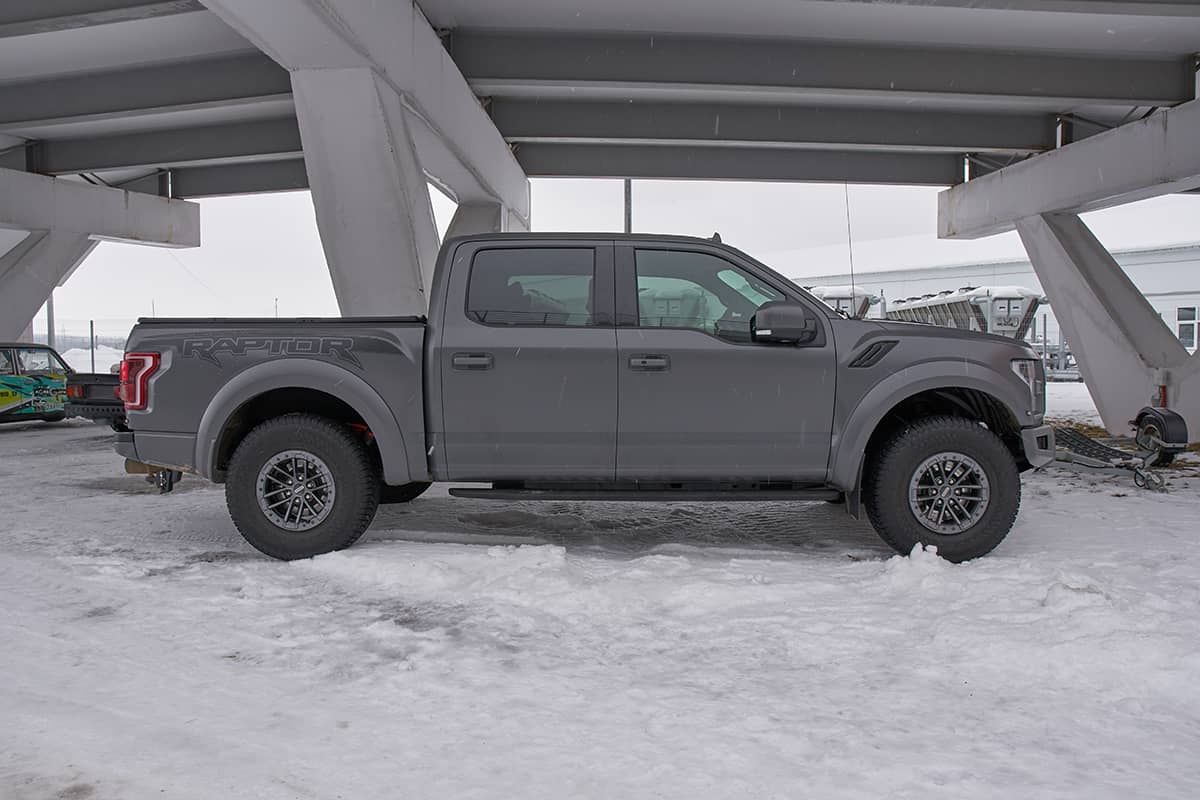The Ford F-150 is a pickup truck that’s been a staple of the American automotive industry for decades. Known for its rugged durability, versatile functionality, and sleek design, the F-150 is the perfect vehicle for those who demand the best from their rides. But before you purchase a brand-new 2023 F-150, you should get a feel for how much it weighs.
The minimum weight of a 2023 Ford F-150 is 4,021 pounds for the 6.5-foot regular cab style. The heaviest F-150 is the Hybrid F-150 with a SuperCrew cabin, weighing in at 5,517 pounds.
In this guide, we’ll discuss the importance of knowing the weight of a pickup truck, how much different versions of the F-150 weigh, and what affects the weight of a pickup.
Pickup Truck Weight
First and foremost, it’s important to know what type of weight we’re referring to. “Weight” in this sense means “curb weight,” which is the weight of a car with a full tank of gas and its standard features. This does not include the weight of passengers and payload. Now, let’s move on.
When choosing a pickup truck, you should always get a good feel for how much it weighs. The weight of a pickup will ultimately impact its performance and capabilities, especially concerning its towing and payload capacities.
A light-duty truck, which is classified as a truck weighing under 8,500 pounds according to the EPA, will usually have lower towing and payload capacities as opposed its heavier-duty counterparts.
However, in exchange for less performance, drivers can enjoy benefits like increased fuel efficiency, improved acceleration, and better handling, especially in high-speed situations. Heavier trucks, on the other hand, can be safer.
Ford F-150 Weight
Being the number-one pickup truck in America for the last 40-plus years, it’s always worth checking up on what Ford is doing to enhance the F-150 driving and handling experience. In terms of weight, however, there’s quite a lot to unpack since the F-150 is available in so many different trim, cabin, and bed options.
Let’s take a quick look at the weight ratings for the available Ford F-150s for 2023. All of the figures below can be found on the official Ford F-150 website.
1. Regular Cab
In Ford F-150s, the Regular Cab style refers to the versions with 2 front doors and a front bench seat for 2 to 3 passengers. It’s the most basic cab configuration and, thus, weighs the least. If you’re looking for a compact F-150 for light to medium-duty tasks, a Regular Cab will most likely fit the bill.
| Engine | 6.5-ft. Bed (2WD) | 6.5-ft. Bed (4WD) | 8.0-ft. Bed (2WD) |
| 3.3L Ti-VCT V6 | 4,021 lbs. | 4,275 lbs. | 4,122 lbs. |
| 2.6L EcoBoost V6 | 4,171 lbs. | 4,441 lbs. | 4,263 lbs. |
| 5.0L Ti-VCT V8 | 4,300 lbs. | 4,564 lbs. | 4,396 lbs. |
| 3.5L EcoBoost V6 | N/A | N/A | 4,428 lbs. |
2. SuperCab
The SuperCab cabin style is the middle ground between the Regular Cab and SuperCrew. It offers a more spacious interior and comfortable seating as opposed to Regular Cab trucks, making them an excellent option for those who are looking for a work truck and a family truck in one package.
| Engine | 6.5-ft. Bed (2WD) | 6.5-ft. Bed (4WD) | 8.0-ft. Bed (2WD) |
| 3.3L Ti-VCT V6 | 4,345 lbs. | 4,598 lbs. | N/A |
| 2.6L EcoBoost V6 | 4,469 lbs. | 4,755 lbs. | 4,574 lbs. |
| 5.0L Ti-VCT V8 | 4,554 lbs. | 4,810 lbs. | 4,675 lbs. |
| 3.5L EcoBoost V6 | 4,607 lbs. | 4,860 lbs. | 4,764 lbs. |
3. SuperCrew
A SuperCrew truck typically has 4 full-sized doors and a front bench seat or individual bucket seats that accommodate up to 6 passengers. They typically have a longer overall length than Regular Cab or SuperCab trucks, providing even more room for passengers and cargo.
| Engine | 5.5-ft. Bed (2WD) | 5.5-ft. Bed (4WD) | 6.5-ft. Bed (2WD) | 6.5-ft. Bed (4WD) | 8.0-ft. Bed (2WD) |
| 3.3L Ti-VCT V6 | 4,465 lbs. | 4,705 lbs. | N/A | N/A | N/A |
| 2.7L EcoBoost V6 | 4,584 lbs. | 4,838 lbs. | 4,616 lbs. | N/A | N/A |
| 5.0L Ti-VCT V8 | 4,661 lbs. | 4,912 lbs. | 4,712 lbs. | 5,014 lbs. | N/A |
| 3.5L EcoBoost V6 | 4,696 lbs. | 4,948 lbs./5,115 lbs.* | 4,752 lbs. | 4,995 lbs. | N/A |
| 3.5L PowerBoost Full Hybrid V6 | 5,260 lbs. | 5,517 lbs. | 5,228 lbs. | 5,540 lbs. | N/A |
| High-Output 3.5L EcoBoost V6 | N/A | 5,740 lbs.**/5,886 lbs.** | N/A | N/A | N/A |
**Raptor
Pickup Truck Weight Comparison
Here, we’re going to compare the base weights of different pickup truck makes and models. This will help you put the Ford F-150’s weight into perspective.
| Pickup Truck Model | Base Weight |
| Ford F-150 | 4,021 lbs. |
| Chevrolet Colorado | 4,488 lbs. |
| Chevrolet S-10 | 4,083 lbs. |
| Chevrolet Silverado 1500 | 5,000 lbs. |
| Ford Ranger | 4,441 lbs. |
| GMC Canyon | 4,456 lbs. |
| GMC Sierra 1500 | 5,050 lbs. |
| GMC Sonoma | 4,025 lbs. |
| Honda Ridgeline | 4,510 lbs. |
| Jeep Gladiator | 5,050 lbs. |
| Nissan Frontier | 4,708 lbs. |
| Nissan Titan | 5,555 lbs. |
| Ram 1500 | 5,082 lbs. |
| Toyota Tacoma | 4,445 lbs. |
| Toyota Tundra | 5,390 lbs. |
Source: Edmunds.com
What Factors Affect Pickup Truck Weight?
1. Body style
The curb weight of a truck is highly sensitive to the cab and bed configuration. SuperCrew cabs with long beds, for instance, tend to be heavier than Regular Cabs with short beds.
2. Engine size
The curb weight of a pickup truck is significantly affected by the size and type of engine installed. Diesel engines, which tend to be heavier than gasoline engines, tend to weigh more than their gasoline counterparts.
3. Drivetrain
The curb weight of a truck may vary from one model to another depending on the type of drivetrain it has, such as 2WD or 4WD. It is possible that the increased mass of a 4WD system, in comparison to a 2WD system, will affect the acceleration and handling of the truck.
4. Equipment and options
The installation of additional features and equipment, such as a towing package, running boards, or a sunroof, can all result in a change in the curb weight of a truck.
5. Material
The materials that are used in the construction of a truck have the potential to have an effect on its curb weight. One clear illustration of this is the substantial weight disparity between aluminum and steel vehicle bodies.






